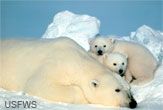Study: Polar Bear Genitals are Shrinking

The icecap may not be the only thing shrinking in the Arctic. The genitals of polar bears in east Greenland are apparently dwindling in size due to industrial pollutants.
Scientists report this shrinkage could, in the worst case scenario, endanger polar bears there and elsewhere by spoiling their love lives and causing their numbers to peter out.
In fact, all marine mammals could get affected by these pollutants, "especially the Arctic fox, killer whale and pilot whales," wildlife veterinarian and toxicologist Christian Sonne at the National Environmental Research Institute of Denmark in Roskilde told LiveScience. These animals bodies also carry extremely high levels of these contaminants.
Polar bears from northernmost Norway, western Russia and east Greenland are among the most polluted animals in the Arctic, as they feast on ringed seals and bearded seals. The blubber of these seals accumulates high levels of organic pollutants loaded with halogens such as chlorine. These organohalogens can act like hormones.
Sonne and his colleagues looked at formaldehyde-preserved genitals from 55 male and 44 female east Greenland polar bears, collected from 1999 to 2002 by about 30 polar bear subsistence hunters regulated by the Greenland government.
Harrowing expedition
The researchers experienced harrowing times on their expeditions with dog sleds into the wilds of Greenland to study polar bears.
Sign up for the Live Science daily newsletter now
Get the world’s most fascinating discoveries delivered straight to your inbox.
"One evening a bear came just next to us in the night when we were doing the toilette," Sonne recalled. "They shot and it ran." Another time, "we almost had to eat the dogs as we ran out of food and seals. It was cold sleeping in -50 degrees C [-58 Fahrenheit] in five weeks with no heater."
The adult polar bear testicles the researchers examined were on average roughly three inches across and 1.8 ounces in weight, although they could dramatically enlarge during the height of sexual activity from January to July. Their bacula, or penis bones, were on average nearly seven inches long.
The scientists found the higher the level of organohalogens in polar bear, the smaller testicle and baculum size and weight likely were. Ovary size and weight decreased as organohalogen levels rose as well.
Slow to mate
Polar bears have among the lowest reproductive rates for terrestrial mammals. The scientists say reducing polar bear penis size would make sex less successful, upsetting naturally slow-to-grow polar bear numbers. Testicle and ovary shrinkage would upset polar bear reproduction too.
Future research should examine the effects of low levels of organohalogen contamination, Sonne said. "How long do we have to go down in exposure levels to obtain no-effect levels? Is it possible at all?" he explained.
Sonne and his colleagues reported their findings online Aug. 16 via the journal Environmental Science & Technology.

Most Popular

